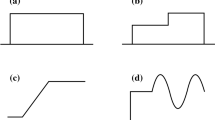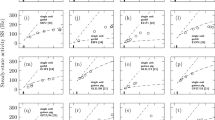Abstract
We present an application of the information distortion approach to neural coding. The approach allows the discovery of neural symbols and the corresponding stimulus space of a neuron or neural ensemble simultaneously and quantitatively, making few assumptions about the nature of either code or relevant features. The neural codebook is derived by quantizing sensory stimuli and neural responses into small reproduction sets, and optimizing the quantization to minimize the information distortion function. The application of this approach to the analysis of coding in sensory interneurons involved a further restriction of the space of allowed quantizers to a smaller family of parametric distributions. We show that, for some cells in this system, a significant amount of information is encoded in patterns of spikes that would not be discovered through analyses based on linear stimulus-response measures.







Similar content being viewed by others
References
Aldworth, Z. N. (2007). Characterization of the neural codebook in an invertebrate sensory system. PhD thesis, Montana State University, Bozeman.
Baba, Y., Hirota, K., & Yamaguchi, T. (1991). Morphology and response properties of wind-sensitive non-giant interneurons in the terminal abdominal ganglion of crickets. Zoological Science, 8, 437–445.
Barlow, H. B. (1961). Possible princilples underlying the transformation of sensory messages. In W. A. Rosenblith, (Ed.), Sensory communications. Cambridge: MIT Press.
Bialek, W., de Ruyter van Steveninck, R. R., & Tishby, N. (2006). Efficient representation as a design principle for neural coding and computation. In 2006 IEEE international symposium on information theory (pp. 659–663).
Biernacki, C., Celeux, G., Govaert, G., & Langrognet, F. (2006). Model-based cluster and discriminant analysis with the mixmod software. Computational Statistics & Data Analysis, 51/2, 587–600.
Bishop, C. M. (1998). Neural networks for pattern recognition. New York: Oxford University Press.
Bodnar, D., Miller, J. P., & Jacobs, G. A. (1991). Anatomy and physiology of identified wind-sensitive local interneurons in the cricket cercal sensory system. Journal of Comparative Physiology A, 168, 553–564.
Buhler, J., & Tompa, M. (2001). Finding motifs using random projections. In Proceedings of the fifth annual international conference on computational biology (pp. 69–76). New York: ACM.
Chechick, G., Globerson, A., Tishby, N., Anderson, M., Young, E. D., & Nelken, I. (2002). Group redundancy measures reveals redundancy reduction in the auditory pathway. In T. G. Dietterich, S. Becker, & Z. Ghahramani, (Eds.) Advances in neural information processing systems (Vol. 14, pp. 173–180). Cambridge: MIT.
Clague, H., Theunissen, F., & Miller, J. P. (1997). The effects of adaptation on neural coding by primary sensor interneurons in the cricket cercal system. Journal of Neurophysiology, 77, 207–220.
Cover, T., & Thomas, J. (1991). Elements of information theory. New York: Wiley.
Dhillon, I. S., Mallela, S., & Modha, D. S. (2003). Information-theoretic co-clustering. In The ninth ACM SIGKDD international conference on knowledge discovery and data mining (KDD 03) (pp. 89–98). New York: ACM.
Dimitrov, A. G., & Miller, J. P. (2001). Neural coding and decoding: communication channels and quantization. Network: Computation in Neural Systems, 12, 441–472.
Dimitrov, A. G., Miller, J. P., Gedeon, T., Aldworth, Z., & Parker, A. E. (2003). Analysis of neural coding through quantization with an information-based distortion measure. Network: Computation in Neural Systems, 14, 151–176.
Efron, B., & Tibshirani, R. J. (1993). An Introduction to the bootstrap. Monographs on Statistics & Applied Probability. New York: Chapman & Hall/CRC.
Gedeon, T., Parker, A. E., & Dimitrov, A. G. (2003). Information distortion and neural coding. Canadian Applied Mathematics Quarterly, 10, 33–70.
Gersho, A., & Gray, R. M. (1992). Vector quantization and signal compression. Kluwer.
Gnatzy, W., & Heusslein, R. (1986). Digger wasp against crickets. I. Receptors involved in the antipredator strategies of the prey. Naturwissenschaften, 73, 212–215.
Heinzel, H. G., & Dambach, M. (1987) Traveling air vortex rings as potential communication signals in a cricket. Journal of Comparative Physiology A, 160, 79–88.
Hirota, K., Sonoda, Y., Baba, Y., & Yamaguchi, T. (1993). Distinction in morphology and behavioral role between dorsal and ventral groups of cricket giant interneurons. Zoological Science, 10(4), 705–709.
Jacobs, G. A., Miller, J. P., & Aldworth, Z. (2008). Computational mechanisms of mechanosensory processing in the cricket. Journal of Experimental Biology, 211(11), 1819–1828.
Jacobs, G. A., & Murphey, R. K. (1987). Segmental origins of the cricket giant interneuron system. Journal of Comparative Neurology, 265, 145–157.
Jaynes, E. T. (1982). On the rationale of maximum-entropy methods. Proceedings of the IEEE, 70, 939–952.
Johnson, D. H., Gruner, C. M., Baggerly, K., & Seshagiri, C. (2001). Information-theoretic analysis of the neural code. Journal of Computational Neuroscience, 10(1), 47–70.
Kamper, G., & Kleindienst, H.-U. (1990). Oscillation of cricket sensory hairs in a low frequency sound field. Journal of Comparative Physiology A, 167, 193–200.
Kanou, M., & Shimozawa, T. A. (1984). Threshold analysis of cricket cercal interneurons by an alternating air-current stimulus. Journal of Comparative Physiology A, 154, 357–365.
Kass, R. E., Ventura, V., & Brown, E. N. (2005). Statistical issues in the analysis of neural data. Journal of Neurophysiology, 94, 8–25.
Kjaer, T. W., Hertz, J. A., & Richmond, B. J. (1994). Decoding cortical neuronal signals: Network models, information estimation and spatial tuning. Journal of Computational Neuroscience, 1(1–2), 109–139.
Landolfa, M., & Jacobs, G. A. (1995). Direction sensitivity of the filiform hair population of the cricket cercal system. Journal of Comparative Physiology A, 177, 759–766.
Landolfa, M. A., & Miller, J. P. (1995). Stimulus-response properties of cricket cercal filiform hair receptors. Journal of Comparative Physiology A, 177, 749–757.
Marmarelis, P. Z., & Marmarelis, V. Z. (1978). The white noise method in system identification. In Analysis of physiological systems. New York: Plenum.
Miller, J. P., Jacobs, G. A., & Theunissen, F. E. (1991). Representation of sensory information in the cricket cercal sensory system. I. Response properties of the primary interneurons. Journal of Neurophysiology, 66, 1680–1689.
Mumey, B., Sarkar, A., Gedeon, T., Dimitrov, A. G., Miller, J. P. (2004). Finding neural codes using random projections. Neurocomputing, 58–60, 19–25.
Osborne, L. C. (1997). Biomechanical properties underlying sensory processing in mechanosensory hairs in the cricket cercal sensory system. PhD thesis, University of California, Berkeley.
Paninski, L., Pillow, J., & Simoncelli, E. (2005). Maximum likelihood estimation of a stochastic integrate-and-fire neural model. Neural Computation, 17, 1480–1507.
Parker, A. E., Dimitrov, A. G., & Gedeon, T. (2010). Symmetry breaking in soft clustering decoding of neural codes. IEEE Transactions on Information Theory, 56(2), 901–927.
Pillow, J. W., Shlens, J., Paninski, L., Sher, A., Litke, A., Simoncelli, E., et al. (2008). Spatio-temporal correlations and visual signaling in a complete neuronal population. Nature, 454, 995–999.
Pillow, J. W., & Simoncelli, E. P. (2006). Dimensionality reduction in neural models: An information-theoretic generalization of spike-triggered average and covariance analysis. Journal of Vision, 6, 414–428.
Rieke, F., Warland, D., de Ruyter van Steveninck, R. R., & Bialek, W. (1997). Spikes: Exploring the neural code. MIT.
Roddey, J. C., Girish, B., & Miller, J. P. (2000). Assessing the performance of neural encoding models in the presence of noise. Journal of Computational Neuroscience, 8, 95–112.
Roddey, J. C., & Jacobs, G. A. (1996). Information theoretic analysis of dynamical encoding by filiform mechanoreceptors in the cricket cercal system. Journal of Neurophysiology, 75, 1365–1376.
Rose, K. (1998). Deteministic annealing for clustering, compression, classification, regerssion, and related optimization problems. Proceedings of the IEEE, 86(11), 2210–2239.
Sakai, H. M. (1992). White-Noise Analysis in Neurophysiology. Physiological Reviews, 72, 491–505.
Schneidman, E., Brenner, N., Tishby, N., de Ruyter van Steveninck, R. R., & Bialek, W. (2000). Universality and individuality in a neural code. In NIPS (pp. 159–165).
Shamir, R., & Sharan, R. (2000). Click: A clustering algorithm with applications to gene expression analysis. In Proceedings of intelligent systems for molecular biology (ISMB) (pp. 307–316).
Shannon, C. E. (1948). A mathematical theory of communication. Bell System Technical Journal, 27, 623–656.
Shimozawa, T., & Kanou, M. (1984a). The aerodynamics and sensory physiology of a range fractionation in the cercal filiform sensilla of the cricket gryllus bimaculatus. Journal of Comparative Physiology A, 155, 495–505.
Shimozawa, T., & Kanou, M. (1984b). Varieties of filiform hairs: Range fractionation by sensory afferents and cercal interneurons of a cricket. Journal of Comparative Physiology A, 155, 485–493.
Slonim, N., & Tishby, N. (2000). Agglomerative information bottleneck. In S. A. Solla, T. K. Leen, & K.-R. Müller, (Eds.), Advances in Neural Information Processing Systems (Vol. 12, pp. 617–623). MIT.
Stout, J. F., DeHaan, C. H., & McGhee, R. W. (1983). Attractiveness of the male acheta domesticus calling song to females. I. Dependence on each of the calling song features. Journal of Comparative Physiology, 153, 509–521.
Theunissen, F., Roddey, J. C., Stufflebeam, S., Clague, H., & Miller, J. P. (1996). Information theoretic analysis of dynamical encoding by four primary sensory interneurons in the cricket cercal system. Journal of Neurophysiology, 75, 1345–1359.
Theunissen, F. E., & Miller, J. P. (1991). Representation of sensory information in the cricket cercal sensory system. II. Information theoretic calculation of system accuracy and optimal tuning curve width of four primary interneurons. Journal of Neurophysiology, 66, 1690–1703.
Tishby, N., Pereira, F., & Bialek, W. (1999). The information bottleneck method. In Proceedings of The 37th annual Allerton conference on communication, control and computing. University of Illinois.
Victor, J. D. (1979). Nonlinear systems analysis: comparison of white noise and sum of sinusoids in biological systems. Proceedings of the National Academy of Sciences of the United States of America, 76(2), 996-998.
Acknowledgements
We would like to thank the two anonymous reviewers for their dedicated work and extremely useful comments that lead to the improvement of this article, and to Dr. John Miller for useful comments and hosting us at the Center for Computational Biology of Montana State University throughout most of the development of this work.
Author information
Authors and Affiliations
Corresponding author
Additional information
Action Editor: Aurel A. Lazar
Rights and permissions
About this article
Cite this article
Dimitrov, A.G., Cummins, G.I., Baker, A. et al. Characterizing the fine structure of a neural sensory code through information distortion. J Comput Neurosci 30, 163–179 (2011). https://doi.org/10.1007/s10827-010-0261-4
Received:
Revised:
Accepted:
Published:
Issue Date:
DOI: https://doi.org/10.1007/s10827-010-0261-4




